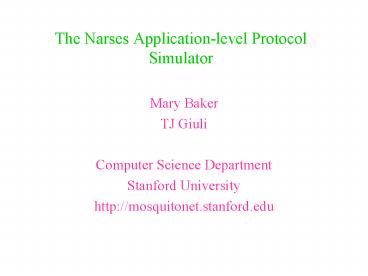The Narses Applicationlevel Protocol Simulator PowerPoint PPT Presentation
1 / 15
Title: The Narses Applicationlevel Protocol Simulator
1
The Narses Application-level Protocol Simulator
- Mary Baker
- TJ Giuli
- Computer Science Department
- Stanford University
- http//mosquitonet.stanford.edu
2
Application protocol simulation - background
- Many large distributed applications
- Peer-to-peer applications
- Web caches
- Content distribution networks
- New fault-tolerant applications
- Want to understand application-level protocol
behavior - Short-term behavior
- Long-term behavior
- Simulate large systems quickly
- Many nodes
- Many flows
- Over long periods of time
3
Problem
- Discrete-event packet simulators not fast enough
- ns, SSFNet, tcpsim, Flowsim, etc.
- Not intended for large application-level
simulations - Detailed models of network layers for accurate
timings - Must handle many events
- Per-packet events (or perhaps packet trains)
- Events at network routers
- Memory consumption is an issue
- ns2 multicast simulations 8194 nodes gt 671MB
- SSFNET 33,300 hosts and routers gt over 2GB
4
What do we need to do?
- Reduce number of simulation events
- Simulate at larger granularity than the packet
- Avoid simulation of network internals (routers,
etc.) - Reduce complexity
- Avoid simulation of lower layers of the network
- Support creating prototype distributed
applications - Simple interface for applications to use
- Run same application stand-alone
- Centralized place for programmers to control
large system - Realistic set of services for distributed
applications
5
Avoid per-packet events
- Simulate message flows instead of packets
- A message flow is a contiguous block of bytes
passed to the transport layer for delivery - No model for lower levels of the network
Higher Layers
message flow
Transport Layer
segmented message
6
Simple network model
- Topology
- End hosts are limited to one connection
- Routers can have unlimited connections
- No restriction on latencies of any connections
- Support for asymmetric links (sort of)
- Two network models for bandwidth so far
- Naïve network model
- Assumes full link bandwidth for each flow
- Used for simulations that count network hops
- Bandwidth-share network model
- Accounts roughly for traffic interdependencies
7
Bandwidth-share network model
- Bottleneck assumed to be at the edge of the
network - Maximum bandwidth between two hosts is the
minimum of the source and destination first-link
bandwidths - Inappropriate for simulating some topologies
- Allows us to avoid modeling routers, Internet
internals
Maximum bandwidth Min(BandwidthS, BandwidthD)
Internet
BandwidthS
BandwidthD
8
Bandwidth allocation
- Take the nominal bandwidth and divide by the
number of flows sent or received by that host - Calculate the bandwidth of the source and
destination hosts of a link, and allocate the
minimum of the two to the flow - Minimum-share allocation
Min(2.5, 1.67)
10Mb
5/3 1.67
10/4 2.5
9
Bandwidth reallocation
- Example
- Flow a completes
- Flow b might now use all of Ys bandwidth
- Reallocate bs bandwidth to be the minimum of
bandwidth available from Y and Z - Flows c and d do not need to be rescheduled,
because number of flows at Z has not changed
c
a
b
d
10
Results
- Compare results of bandwidth-share model to ns
- Time to perform the simulations
- Memory usage
- Accuracy
- Run identical simulations
- Topology generated by GT-ITM topology generator
- 600 nodes, no bottleneck links between end hosts
- Avg. round-trip path latency in ns 96ms, max. is
190 ms - Avg. round-trip path latency in Narses 88ms, max.
158 ms - Flows sent between random hosts, flows all the
same size - 1GHz Pentium III with 512MB RAM running RedHat 7.2
11
Runtime (10,000 flows)
12
Memory consumption (5000 to 20000 flows)
- Flow size 200KB
- At 40,000 flows, ns thrashed
13
Accuracy (10,000 flows)
14
Impact
- Used for simulating several distributed
applications - Byzantine fault-tolerant protocols
- CUP
- LOCKSS
- Other peer-to-peer applications
- Considered easy to incorporate application
- Easy to run application stand-alone instead
- Application must be written in Java currently
15
Future work
- Simulate larger topologies
- Calculating route table information in ns is
current bottleneck - Look at JavaSim technology
- With help from Prof. Hou
- Implement UDP model
- Narcissus
- How can I tell if a topology is appropriate?
- Performance improvements
- Use calendar scheduler such as ns does
- Implement our own object manager
- Avoid Java garbage collection overhead
- Model congested back channels

